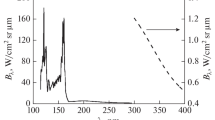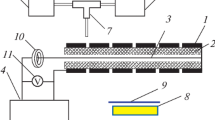Abstract
The method of radiation recording in the near-ultraviolet range arising at the surface electric discharge. In the experiment, a double-electrode cell is used in the mode of a power supply by a single rectangular pulse of positive polarity. Using a photoelectric multiplier, a coincidence between the moment of appearance of the discharge current and moment of appearance of the radiation arising at it is specified, which is important for determination of the initial voltage of appearance of the discharge.
Similar content being viewed by others
Avoid common mistakes on your manuscript.
The main recorded parameters during experimental investigations of the surface discharge are voltage applied between the electrodes and discharge current. Generally, their recording is sufficient to determine the voltage, at which the discharge appears (initial voltage U0) and record the time of beginning of its development. In Fig. 1, an oscilloscope pattern is presented obtained using a Tektronix DPO 7354C wideband oscilloscope with a bandwidth of 3.5 GHz, on which a leading edge of the positive pulse voltage initiating the discharge is presented, as well as the discharge current pulse. The pulse amplitude was smoothly regulated within the range of 0–10 kV, the pulse duration by the level 0.1 was 5 μs, and the front and droop duration did not exceed 150 ns. All measurements were performed in the single-shot mode of the high-voltage generator and recording oscilloscope. The initial voltage was determined according to the discharge current rush: a vertical line was drawn from the point corresponding to the current initiation to the intersection with the voltage oscilloscope pattern, and a horizontal line was drawn through this point to the intersection with the ordinate axis, from which the initial voltage was specified.
In addition to the electrical characteristics of the discharge, there is one more important characteristic—optical radiation arising at the discharge. Most experiments investigating the surface discharge have been carried out in air, which entails the appearance of the spectral lines in the near-ultraviolet range in the radiation spectrum referring to nitrogen. Recording the time dependence of change of the intensity of some spectral lines (bands), the additional information about the physical processes flowing at all stages of development of the surface discharge can be obtained. In addition, recording the light pulse allows specifying the moment of discharge initiation more precisely. The optical circuit of recording the radiation and structure of the discharge cell are shown in Fig. 2. The discharge cell is a double-electrode structure located on the dielectric plate. The discharge and radiation caused by it arise at the electrode edge when the high-voltage pulse is supplied to it from the output of a high-voltage impulse generator (HVIG). The radiation from the near-electrode area is projected to the surface of the cathode of an M11FVC520 photoelectric multiplier (PEM) by means of optical quartz lens L. In the FEM anode circuit, load resistor R = 50 Ω is installed, the electric signal from which is transmitted to the oscilloscope input by the coaxial cable. The power supply of the photoelectric multiplier is carried out from a high-voltage regulated constant voltage source (CVS) (BNV3-05).
In the radiation arising simultaneously with the electric discharge, the bands are dominant that refer to the second positive nitrogen system, in particular, in the range λ = 337.13 nm. This is one of the most intense bands. Nearby, there are other bands in the range from 357 to 406 nm. To exclude mutual overlapping of radiation from different parts of the spectrum, either a monochromator or a narrow-band filter should be used. In this case, interference filter IF is used that is located between the lens and photoelectric multiplier. The transmission factor of the filter at wavelength λ = 336 nm was 20%, and the width of the transmission band by the level of 0.5 was Δλ = 10 nm, which allowed specifying the radiation exactly at wavelength λ = 337.13 nm.
Some features should be noted related with the use of a PEM. First, the PEM should have a sufficient spectral sensitivity in the near-ultraviolet spectrum and the high time resolution necessary to record the light pulses of the nanosecond range. It is not difficult to select a PEM meeting these requirements from those available, but there one parameter is particularly important—the transit time of the photoelectrons from the photocathode to the anode inside the PEM. In fact, this time characterizes the internal delay of the signal, which depends on the PEM dimensions, structure of its diode system, and supply voltage, all of which affect the transit time. Apart from the above mentioned, the length of the wave of the recorded radiation also affects the transit time, as the initial velocity of the photoelectrons depends on the wave length and operation of the photocathode output. In the reference literature, sometimes only a guide value of the delay is specified, which is in the range from units to tens of nanoseconds. The presence of the internal delay leads to the fact that, during simultaneous recording of the voltage and current, the oscilloscope pattern corresponding to the radiation turns to be displaced as to the oscilloscope pattern of the current. This displacement should be considered during further processing of the experimental data. Thus, the exact time of the delay of the signal directly in the used PEM should be determined by means of the additional experiments with a certain supply voltage and certain wavelength.
The measuring circuit of the time delay arising between the light pulse delivered to the PEM photocathode and moment of appearance of the electric signal on the PEM loading resistor is similar to that presented in Fig. 2; however, the discharge cell has been replaced by the semiconducting radiation source. The operation mode of the light-emitting diode is pulsed. The electric pulse initiating the radiation was delivered to the light-emitting diode from the output of an AKIP 3409 double-channel generator. The second channel of the generator was used to synchronize the start of the oscilloscope. The, the time delay was measured between the fronts of the synchronization pulse and photoelectric current pulse from the PEM output and dependence of this delay on the PEM supply voltage and wavelength. The results of measurements in one of the experiments are given in Fig. 3. The delay was 70 ns for a specific specimen of the PEM (M11FVC520) with a supply voltage of 1000 V and use of a light-emitting diode radiating at wavelength λ = 464 nm. This is a rather high value compared to the time of development of the discharge in the cell. The delay was 52 ± 4 ns during a simultaneous oscillograph recording of voltage on the discharge cell, discharge current, and radiation of the discharge at a wavelength of 337.13 nm. In this case, 52 ns is the hardware value that should be considered during processing and the range of 4 ns is determined by various fluctuation processes. The oscilloscope pattern in shown in Fig. 4 corresponding to the real-time sequence of the signals.
CONCLUSIONS
It has been experimentally confirmed that optical radiation also appears simultaneously with the current pulse during a surface electric discharge in the double-electrode system at the initial stage of its development. The radiation pulse curve shape is similar to the current pulse curve shape, which allows determining the breakdown voltage not only by the current rush in the oscilloscope pattern, but also by the radiation ignition.
Author information
Authors and Affiliations
Corresponding author
About this article
Cite this article
Malakhov, Y.I., Voevodin, V.V. & Sokolova, M.V. Recording Radiation in the Near-Ultraviolet Range to Determine the Initial Ignition Voltage of Surface Discharge in Air. Russ. Electr. Engin. 89, 477–479 (2018). https://doi.org/10.3103/S1068371218080084
Received:
Published:
Issue Date:
DOI: https://doi.org/10.3103/S1068371218080084








